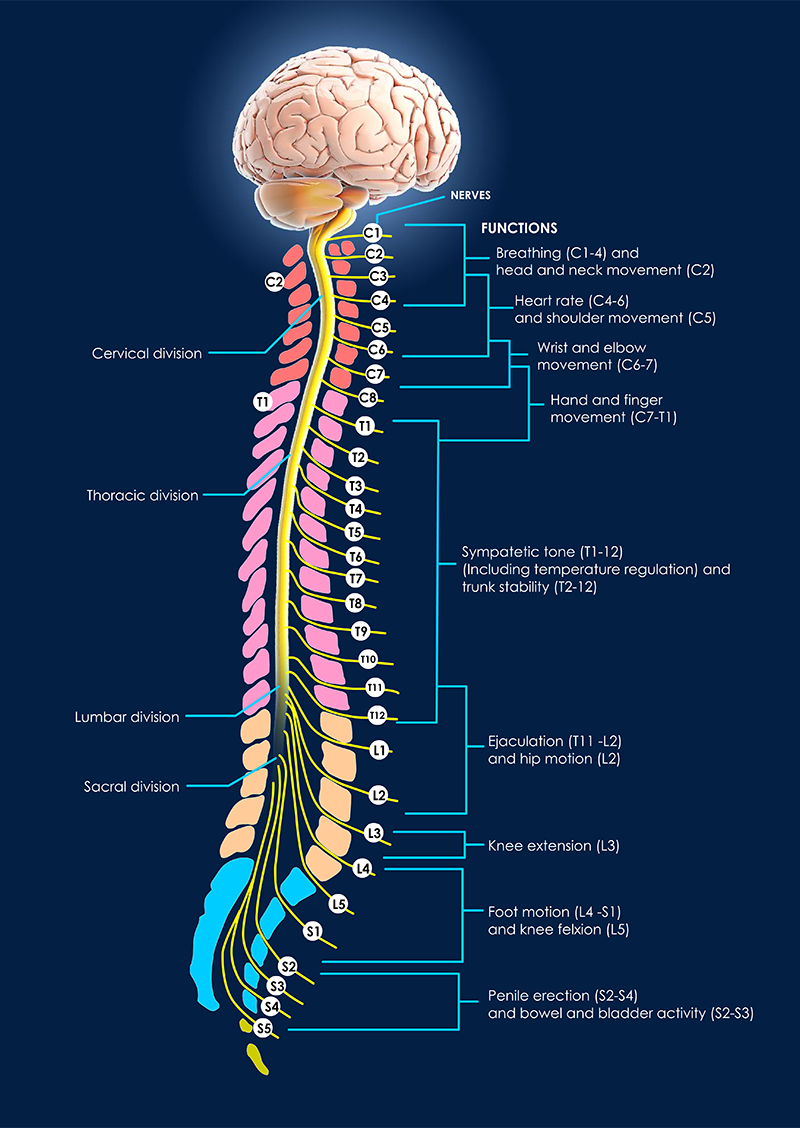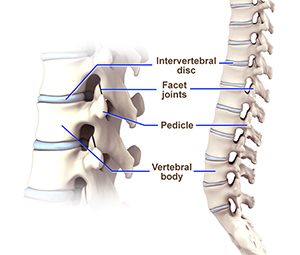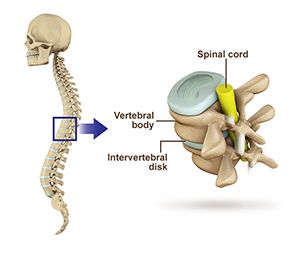Spine Surgery
Dr Tollesson is a valued member of the AOSpine society. Please refer to their website for more information using the link below:
www.aofoundation.org
Additional information regarding spine surgery can also be found at the Spine Health website using the link below:
www.spine-health.com
Cervical Spine Surgery
Spinal Anatomy
Cervical Spine Anatomy
The spine, also called the back bone, plays a vital role in stability, smooth movement and protection of the delicate spinal cord. It is made up of bony segments called vertebrae with fibrous tissue called intervertebral discs between them. The vertebra and discs form the spinal column from the head to the pelvis, giving symmetry and support to the body.
For more information about Spinal Anatomy, click on below tab.
Cervical Spinal Stenosis
Cervical spine refers to neck portion of spine, and cervical spine conditions may result from overuse injuries, trauma and certain diseases. Cervical stenosis refers to narrowing of the spinal canal that protects the spinal cord and its branching nerves. The condition causes neck pain radiating to arms and hands, numbness or weakness in the legs. This condition causes cervical myelopathy and cervical radiculopathy. The abnormal pressure placed on the spinal cord causes damage and results in spinal cord dysfunction. This condition is known as myelopathy. Cervical radiculopathy occurs when the nerve root connecting the spinal cord is injured or pinched as they exit the spinal canal. Myeloradiculopathy occurs when there is damage to the spinal cord and nerve roots.
For more information about Cervical Spinal Stenosis, click on below tab.
Disc Protrusions
Cervical disc protrusion, commonly known as disc bulge occurs when the spinal discs and associated ligaments are intact, but may form a bulge that will press on the spinal nerves. This condition causes pain in the neck, shoulder and the arms. Usually, the symptoms include a dull, aching, or sharp pain in the neck or the shoulder blades. Sometimes, the pain may radiate along the arms to the hands and fingers. Tingling sensation and numbness may be felt at the fingertips. It generally develops in individuals in age group of 30–50 years as a result of trauma to the cervical spine.
For more information about Disc Protrusions, click on below tab.
Anterior Cervical Discectomy – Inter Body Cage
For more information about Anterior Cervical Discectomy, click on below tab.
Anterior Cervical Discectomy and Fusion (ACDF)
Anterior cervical discectomy with fusion is an operative procedure to relieve compression or pressure on nerve roots and/or the spinal cord due to a herniated disc or bone spur in the neck.
For more information about ACDF, click on below tab.
Cervical Arthroplasty
For more information about Cervical Arthroplasty, click on below tab.
Cervical Foraminotomy
Cervical foraminotomy is an operative procedure to relieve the symptoms of pinched or compressed spinal nerve by enlarging the neural foramen, an opening for the nerve roots to exit from the spine and travel throughout the body. The neural foramen forms a protective passageway for nerves that transmit signals among the spinal cord and the rest of the body parts.
For more information about Cervical Foraminotomy, click on below tab.
Cervical Laminectomy
A cervical laminectomy is an operative procedure of removing the bone at the neck (cervical spine) region to relieve pressure on the spinal nerves. It can also be performed to relieve the symptoms of narrowed spinal canal known as spinal stenosis.
For more information about Cervical Laminectomy, click on below tab.
Cervical Laminoplasty
A cervical laminoplasty is an operative procedure that involves reshaping/repositioning the bone at the neck region (cervical spine) to relieve excess pressure on the spinal nerves. It can also be performed to relieve the symptoms of narrowed spinal canal known as spinal stenosis.
For more information about Cervical Laminoplasty, click on below tab.
Surgery for Cervical Spinal Trauma
For more information about Surgery for Cervical Spinal Trauma, click on below tab.
Surgery for Cervical Radiculopathy
Cervical radiculopathy refers to neck pain that radiates to the shoulder and arm caused by injury or compression of a spinal nerve root in the neck region. Cervical radiculopathy is also referred to as nerve root impingement, nerve entrapment, or pinched nerve. The condition is more common in adults and elderly individuals and rare among young individuals.
For more information about Surgery for Cervical Radiculopathy, click on below tab.
Surgery for Cervical Myelopathy
For more information about Surgery for Cervical Myelopathy, click on below tab.
Surgery for Cervical Spinal Tumours
For more information about Surgery for Cervical Spinal Tumours, click on below tab.
Surgery for Degenerative Disc Disease
Cervical degenerative disc disease (DDD) is a misnomer as it is not a disease as such but a condition that affects the strength, resiliency and structural integrity of the intervertebral discs due to increasing age, trauma, injury, repetitive movement, improper posture, or poor body mechanics.
For more information about Surgery for Degenerative Disc Disease, click on below tab.
Thoracic and Lumbar Spine Surgery
Decompressive Lumbar Laminectomy
For more information about Decompressive Lumbar Laminectomy, click on below tab.
Lumbar Disc Disease
Lumbar Degenerative Disc Disease (DDD) is a common cause of low back pain. The vertebrae are cushioned by intervertebral discs which act as shock absorbers, for the spine. Over time, these natural shock absorbers wear out and degenerate due to aging, trauma or injury leading to DDD. Degenerative disc disease is not actually a disease but refers to the changes in the spine that occur as a part of the normal aging process.
For more information about Lumbar Disc Disease, click on below tab.
Lumbar Spinal Stenosis
Lumbar stenosis is the compression of spinal nerves caused by narrowing of spinal canal and it is one of the common causes of low back pain. Spinal stenosis can also affect the spine in neck region. The symptoms include back pain, burning or aching type of pain in buttocks that radiates to the legs (sciatica), weakness in the legs or “foot drop”. One of the causes for spinal stenosis is the ageing and other causes include Paget’s disease, achondroplasia, spinal tumours and spinal injuries. As age advances the chances of developing osteoarthritis, disc degeneration and thickening of ligaments may increase and these conditions cause spinal stenosis.
For more information about Lumbar Spinal Stenosis, click on below tab.
Spondylolisthesis
Spondylolisthesis is the displacement of vertebral disc from the spinal column. Outward (forward) displacement is termed as anterolisthesis and inward (backward) displacement is termed as retrolisthesis. This condition is often preceded by spondylolysis, a degenerative condition of the vertebra.
For more information about Spondylolisthesis, click on below tab.
Lumbar Decompression Laminectomy
For more information about Decompressive Lumbar Laminectomy, click on below tab.
Lumbar Decompression and Pedicle Screw Instrumented Fusion for Spondylolisthesis
For more information about Lumbar Decompression and Pedicle Screw, click on below tab.
Lumbar Laminectomy for Discectomy
For more information about Lumbar Laminectomy for Discectomy, click on below tab.
Lumbar Microdiscectomy
For more information about Lumbar Microdiscectomy, click on below tab.
Lumbar Microdiscectomy and Rhizolysis
For more information about Lumbar Microdiscectomy and Rhizolysis, click on below tab.
Minimally Invasive Decompression for Lumbar Canal Stenosis
For more information about Minimally Invasive Decompression, click on below tab.
Minimally Invasive Lumbar Discectomy
For more information about Minimally Invasive Lumbar Discectomy, click on below tab.
Posterior Lumbar Interbody Fusion and Decompression (PLIF) / (TLIF) Transforaminal Lumbar Interbody Fusion
Spinal fusion, also called arthrodesis, is a surgical technique used to join two or more vertebrae (bones) within the spine. Lumbar fusion technique is the procedure of fusing the vertebrae in lumbar (lower back) portion of the spine.
For more information about PLIF / TLIF, click on below tab.
Surgery for Thoracic and Lumbar Spinal Trauma
For more information about Surgery for Thoracic and Lumbar Spinal Trauma, click on below tab.
Surgery for Lumbar Radiculopathy / Sciatica
Radiculopathy is a painful condition resulting from compression or inflammation of spinal nerves. Lumbar radiculopathy is a condition in which the spinal nerves around the lumbar region (lower back) are compressed or pinched leading to pain, numbness or weakness, and tingling sensation.
For more information about Surgery for Lumbar Radiculopathy / sciatica, click on below tab.
Surgery for Lower Back Pain as for Pain in the Thoracic Spine
For more information about Surgery for Lower Back Pain as for Pain in the Thoracic Spine, click on below tab.
Surgery for Thoracic or Lumbar Spinal Stenosis
Lumbar spinal stenosis refers to the narrowing of the spinal canal and /or the vertebral foramina in the lower back. This causes compression of the spinal cord (lumbar central canal stenosis) and of the spinal nerves (lumbar foraminal stenosis) passing through the vertebral foramina.
For more information about Surgery for Thoracic or Lumbar Spinal Stenosis, click on below tab.
Surgery for Thoracic and Lumbar Spinal Tumours
For more information about Surgery for Thoracic and Lumbar Spinal Tumours, click on below tab.
Surgery for Thoracic and Lumbar Spinal Tumours
Cervical degenerative disc disease (DDD) is a misnomer as it is not a disease as such but a condition that affects the strength, resiliency and structural integrity of the intervertebral discs due to increasing age, trauma, injury, repetitive movement, improper posture, or poor body mechanics.
For more information about Surgery for Thoracic and Lumbar Spinal Tumours, click on below tab.
Surgery to Improve Sagittal Balance and Posture
For more information about Surgery to Improve Sagittal Balance and Posture, click on below tab.
Spinal fusions
Posterior Lumbar Interbody Fusion (PLIF)
Anterior lumbar interbody fusion (ALIF) is a surgical procedure to correct the spinal problems from the front of the vertebral body by removing disc or other bone material from in between two adjacent lumbar vertebrae. The surgery can be implemented either as an open surgery or minimally invasive techniques.
For more information about Posterior Lumbar Interbody Fusion (PLIF), click on below tab.
Direct lateral Interbody Fusion (DLIF)
For more information about Direct lateral Interbody Fusion (DLIF), click on below tab.
Surgery for Spondylolysis
For more information about Surgery for Spondylolysis, click on below tab.
Surgery for Spondylolisthesis
Spondylolisthesis is a condition of the spine characterized by the forward displacement of a vertebra over an underlying vertebra. A significant displacement can cause a compression of the spinal nerves resulting in pain. The two most common types of spondylolisthesis include dysplastic spondylolisthesis and isthmic Spondylolisthesis.
For more information about Surgery for Spondylolisthesis, click on below tab.




